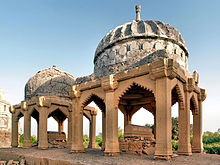On 14 August 1947, Mirpur was part of the princely state of Kashmir under the rule of Maharaja Hari Singh. A revolt against his rule erupted with the advent of Pakistan. This gained momentum by the invasion of Pushtun tribesmen from . Most of Kashmir's state forces had barricaded themselves in Mirpur after having retreated from the surrounding posts in particular from Mangla Fort. On the outskirts of the city, the local rebels, being mainly retired army personnel from British and state's armies and defectors from the state's army, attacked the Maharaja's forces on 4 November 1947. Between 6 and 11 November, heavy battles between the former and Indian forces took place within the city. Mirpur city was captured by local rebels on 11 November and the rest of Mirpur district was captured by 25 November 1947. Pakistan Army helped at a later stage to restore law and order.ecome industrial workers in Britain. So when the Mangla Dam was about to be constructed in 1960, the affectees of the dam who were going to be deprived of their agricultural land were afforded the opportunity to migrate to the United Kingdom and to join those of their kinsfolk who long before had established themselves in Britain.n fact the remains of the old city (old Mirpur) are underneath the waters of the Mangla Lake, during colder months March, April the water level recedes to such an extent that one can travel on motorcycle on old mirpur road which still exists. Holy Shrines of Syed Abdul Karim and Meeran Shah Ghazi brcome visible and also the remnants of a Sikhgurdwara as well as a Hindu mandir possibly dedicated to the "mangla mata" (mangla mother goddess). Remains of old houses, water wells, Grave yards also reappear in the months of March and April. People of Mirpur visit the old Mirpur during these months to pay homage to their previous land they lived on and pray on grave yards of their loved ones. Urs Mubarak of Meeran Shah and Syed Abdul Kareem are also arranged in these months in old Mirpur.
The remains of old Mirpur depict a silhouette of pre-partition city when many faiths co-existed side by side. However after division of the State of Jammu Kashmir, the non-Muslim community consisting of Hindus, Buddhists and Sikhs fled to Jammu. The New Mirpur city has been well planned with construction of modern designed buildings and ample roads serving each part of city. The affluence brought on by immigration mainly to the UK is reflected by the structure and grandiose of the residential houses. There are tell-tale signs of inward investment by the expatriate community living in the United Kingdom, Europe, North America and the Middle East. The city has a number of good hotels, restaurants, shopping malls and other urban facilities.As part of the relief/compensation package in the wake of Mangla Dam Raising Project, a New City is being developed along the south eastern outskirts of Mirpur. Civil works at huge scale are going on around the whole district, by the Pakistani & Chinese contractors for raising the dam. Four towns in the district have been planned besides the new city, to resettle the population affected by the project.nown as the shopping capital of Azad Kashmir, Mirpur has a large and diverse shopping area, centred around Chowk Shaheed,Mian Mohammed Road and Allama Iqbal Road. There are many stores, plazas, shopping malls and markets in these thoroughfares, selling everything from hand made pottery to international brands, and there are many bargains to hand as haggling is common in smaller stores. The currently under construction Nosha Shopping Centre will be one of the largest shopping centres of the city when completed. Azad Mega Mart is the well known shopping plaza of the city and is a hotspot for people visiting Mirpur city. Near the police lines, Puranni Hattian (Syed Naik Alam Shah Road) is famed for its high and top




Comments
Post a Comment